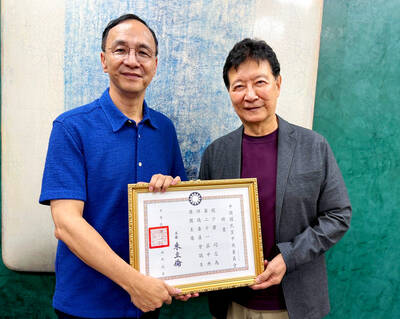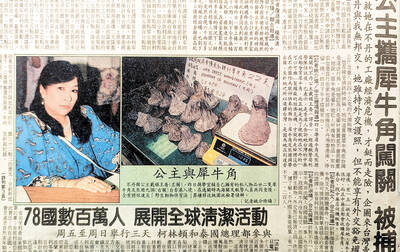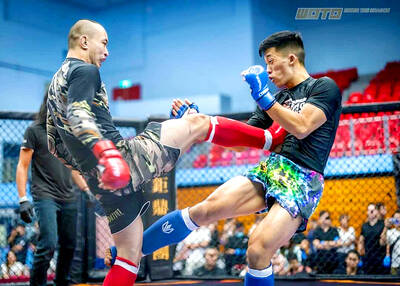When Steven Lien, a onetime ski-shop proprietor and information technology specialist in Portland, Oregon, dreamed up a small-business venture last year, his friends and family were not even polite about what they thought of his prospects.
"Everyone was like, 'There's no way that will work,"' Lien recalled.
Now, almost five months since Under U 4 Men opened its doors on Broadway in the heart of downtown Portland's business district, Lien could open a restaurant just to serve humble pie. Instead, he is planning two more branches. His small specialty store, which sells only novel or little-known brands of men's underwear, has outperformed even his own forecast.
"The store was profitable within 30 days," he said. "And I didn't open on Gay Street, USA. I opened on Main Street, USA."
Novelty underwear, for decades the butt of jokes, has, in the last two to three years, turned into a serious business, capturing a significant share of the US$1.1 billion men's knit-underwear (that is, excluding boxers) market. In all their goofy glory, briefs in bright colors, zany prints, new materials and daring cuts are undermining the classic white brief's long-held status as king of the hill. In 2006, white's share of the market dipped below 50 percent for the first time in decades, if not ever.
It is hard to believe, so eyebrow-raisingly offbeat, and atypically masculine, are many of the selections. The cheery rainbow of colors, 20 in all, at American Apparel. The low-low rise of Go Softwear briefs. Bamboo fabric from C-IN2 and soy-based fabric from 2(x)ist. Oversize race-car prints from Diesel. Soccer graphics in Andrew Christian's new line. Groovy 1970s-sunset supergraphics on Frank Dandy Superwear. And, unlikeliest of all, the little-boy, Underoos-inspired nuttiness of fire trucks, motorcycles and hot dogs all over Ginch Gonch underwear — they're fairly crying out to be called underpants.
Not since the Peacock Revolution of the 1960s has there been such variety, all of it going to disprove a cherished maxim of men's wear: that a man is more loyal to his brand of underwear than to any other article of clothing. Now connoisseurship trumps loyalty. Once-tentative customers now log on to sites like InternationalJock.com, one of the most comprehensive men's underwear Web sites, selling brands like Justus Boyz, Wax, Play, Kyle, Artificial Flavor and AussieBum.
"There's been an explosion in printed underwear, low-rise underwear and different kinds of boxer briefs," said John Sievers, an owner of International Jock, who said that his business has doubled in three years. Underwear by C-IN2 and Andrew Christian, artfully constructed with seams or straps to make the most of a man's, um, profile, has done extremely well, he added. "All the Wonderbra sort of technology for men — we sell tonnes of stuff like that."
city slickers' knickers
As they say, it's all about packaging. For American Apparel, that means marketing that is a clash of squeaky clean and slightly raunchy. Picture an unshowered, unshaven guy in a pair of pink briefs with white piping, photographed amateur-style, and you get the idea. Using such imagery, American Apparel has sold more than a million of its briefs in the two years since they were introduced, according to Dov Charney, the line's founder. "They're one of our best-selling products now," he said.
And the wacky Web site for Ginch Gonch (the name is taken from Canadian slang for underwear) offers a YouTube-style wedgie contest and scads of naughty double entendres. The racy-goofy approach is working: Ginch Gonch sold 1.8 million pairs of underwear last year at about US$30 each, according to Jason Sutherland, the line's owner, who said he expects to double that volume in this year.
"They're getting away from the old pasty colors," said Maurice Webb, a infrastructure contractor and an Army veteran based in Iraq, who stumbled onto the Justus Boyz site when searching for new underwear. "They've got a lot of fun stuff now. They're taking notice that there are stylish, daring people out there."
At first the site — and name — made him nervous, but the desert camo briefs he bought were a hit. "I got a lot of compliments," he said. "They're more form-fitting, and they're also more comfortable."
His reaction would seem to be shared by many. From 2004 to 2006, sales of men's knit underwear rose 5.3 percent, to 397 million pairs, according to NPD Group, which tracks clothing trends. The gains were from styles in patterns (up 23 percent, to 48 million pairs) and solid colors (also up 23 percent, to 156 million), including the blacks and grays that mainstream makers like Calvin Klein and Hanes added to their lines. Similarly, sales of traditional briefs were down while nontraditional styles — boxer briefs, bikinis and thong styles — were all up.
"It's becoming very exciting," said Marshal Cohen, the chief analyst at NPD. "For a long time it seemed like, if you wanted to wear briefs, you couldn't have any personality."
The big losers offsetting the gains? White underwear styles fell 9.4 percent in the last two years.
And because underwear is one of the few forms of men's wear that women buy more of (for men) than men do, Cohen said the trend would likely continue as the boyfriends and husbands start to replacement-shop for themselves.
It's all a far cry from 1951, when C. Willett and Phillis Cunnington wrote, in The History of Underclothes, that "man has never used provocative underclothing." The "plain prose" of men's underwear, they said, was "in singular contrast to the poetical allurements worn by woman."
Don't toe the panty line
How the sensational 1934 introduction of briefs — then called jock-style, Y-front or bathing-suit underwear because they were styled after a very brief French swimsuit — escaped their notice is puzzling. Especially given that the brief's popularity (and its encoded meaning as hypermasculine attire) was cemented, in 1938, with the celebrity endorsement as the underwear of choice (in blue) of a nerdy yet steel-built reporter named Clark Kent. (How are the mighty fallen: Old-school white Y-fronts recently got a more dubious superhero plug as the costume of Captain Underpants, the chubby middle-aged title character in a children's books series.)
Just 25 years ago, Calvin Klein took aim at the underwear industry when he turned an Olympic pole-vaulter into his own sexed-up version of Michelangelo's David, this time in white cotton briefs. Until he sold the company in 2002, Klein pushed the envelope with provocative campaigns, securing a spot for his Calvins among the top five best-selling underwear brands, where they remain in spite of (or because of) a far tamer marketing strategy.
Now Calvin Klein is the Goliath, and if the slingshots wielded today are more in the spirit of spitballs and water balloons, that's the idea. This youthful version of masculinity is, while still sexy, far from the ripped and buffed torsos that became a cliche of men's underwear packaging.
"To me, the man on the Calvin Klein package is the man I am not, and the man I cannot be," said Charney of American Apparel. "You know, nerdy is in."
Daniel Fogg, 27, a marketing manager in Portland who had shopped on Internet sites until he discovered Under U 4 Men, appreciates packaging that is less body-obsessed. "That's one of the differences with the newer brands," he said. "It's not so oversexualized. It can be approached as something fun to shop for at the same time that you buy a pair of shoes or jeans."
Department stores like Saks Fifth Avenue have heard the call, selling designer underwear from D&G and Dsquared alongside the collections, not in the underwear department. In the last two years Saks has doubled the brands of underwear it carries.
Though sales of specialty underwear were once driven by gay men, that has changed, even if they are still more-daring consumers of new styles. "It's absolutely not a gay thing," said Michael Macko, the men's fashion director at Saks. "Straight guys want to be sexy, too."
Countering another preconception, he added: "It's not necessarily a young guy buying them. Who doesn't want to dress younger? No one wants to think, 'I want to look old and grumpy.' They think, 'I want to look younger and better."'
Indeed, Cohen of NPD suggested that Viagra was helping to fuel the trend, putting guys who had been benched back in the underwear game. "It's for young guys as well as the boomer consumer," he said.
Bruce Steakley, 58, a nurse in McLean, Virginia, who has bought several colorful briefs from the International Jock Web site, agreed with the assessment. "People who once seemed older no longer do," he said. In addition to a better fit and comfort, these styles, he added, "are just more fun and more attractive."
In other words, you are only as old as your underwear.

Last week the story of the giant illegal crater dug in Kaohsiung’s Meinong District (美濃) emerged into the public consciousness. The site was used for sand and gravel extraction, and then filled with construction waste. Locals referred to it sardonically as the “Meinong Grand Canyon,” according to media reports, because it was 2 hectares in length and 10 meters deep. The land involved included both state-owned and local farm land. Local media said that the site had generated NT$300 million in profits, against fines of a few million and the loss of some excavators. OFFICIAL CORRUPTION? The site had been seized

Next week, candidates will officially register to run for chair of the Chinese Nationalist Party (KMT). By the end of Friday, we will know who has registered for the Oct. 18 election. The number of declared candidates has been fluctuating daily. Some candidates registering may be disqualified, so the final list may be in flux for weeks. The list of likely candidates ranges from deep blue to deeper blue to deepest blue, bordering on red (pro-Chinese Communist Party, CCP). Unless current Chairman Eric Chu (朱立倫) can be convinced to run for re-election, the party looks likely to shift towards more hardline

Sept. 15 to Sept. 21 A Bhutanese princess caught at Taoyuan Airport with 22 rhino horns — worth about NT$31 million today — might have been just another curious front-page story. But the Sept. 17, 1993 incident came at a sensitive moment. Taiwan, dubbed “Die-wan” by the British conservationist group Environmental Investigation Agency (EIA), was under international fire for being a major hub for rhino horn. Just 10 days earlier, US secretary of the interior Bruce Babbitt had recommended sanctions against Taiwan for its “failure to end its participation in rhinoceros horn trade.” Even though Taiwan had restricted imports since 1985 and enacted

Enter the Dragon 13 will bring Taiwan’s first taste of Dirty Boxing Sunday at Taipei Gymnasium, one highlight of a mixed-rules card blending new formats with traditional MMA. The undercard starts at 10:30am, with the main card beginning at 4pm. Tickets are NT$1,200. Dirty Boxing is a US-born ruleset popularized by fighters Mike Perry and Jon Jones as an alternative to boxing. The format has gained traction overseas, with its inaugural championship streamed free to millions on YouTube, Facebook and Instagram. Taiwan’s version allows punches and elbows with clinch striking, but bans kicks, knees and takedowns. The rules are stricter than the